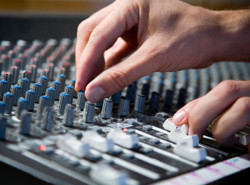
Therefore, I threw in the towel years ago and came up with a separate monitor system that is cost effective, mobile, easy to set up/take down and keeps the musicians happy. And, it works well if you work with one particular band or several.
My gear list includes a 16-channel rack-mount mixer, two dual-15-band equalizers, a 16-channel rack-mount snake, a 1/4-inch patch bay and a rack on wheels.
Of course, depending upon need, the size of the console and snake can vary, and compressors, gates and effects units (and so on) can be added. Digital consoles also provide a lot of the comps, gates, effects and more that used to require separate outboard gear.
The main thing is to try to keep it all in one reasonably sized rack and pre-wired as much as possible.
I roll this on to the club stage, and then run three sub snakes: stage right, stage left and drums. These sub snakes plug into the splitter snake, which is mounted in the front of the rack.
The patch bay is also mounted at the rack front, and it provides sends to the monitor wedges, which are powered, by the way. (There are some amazing powered monitors these days.) When using non-powered wedges, I simply route from the patch bay to the monitor amplifier rack.
The only thing left to do is plug the splitter snake into the FOH snake, and then plug in the power. Having all connections at the front of the rack makes for fast and hassle-free interconnect, one of the big objects of this exercise.
When the band arrives, I dial in this monitor system for them, and then leave the rest to them. Each person in my band is familiar with this rig, and makes adjustments themselves throughout the night as needed.
If working with a different band, I still dial it in at the beginning of the night, with any adjustments made quickly during a break.
Driving Them Crazy
This, of course, brings me to the point that the monitor system needs to be as simple to operate as possible, and thus, it’s the reason I don’t include extra effects units.
Our drummer, however, does want some effects in his monitor, so I set him up with a small rack containing a rack-mount mixer and the effects unit he prefers. His monitor send routes to this rack and then to his wedge.
As you can imagine, the drummer was very happy about this. But the addition of effects to the vocals, guitar and keyboard in his mix drove the rest of the band crazy, because they could now hear reverb on things they didn’t want to hear it on. (Sigh…)
To fix this problem, I send two mixes from the monitor mixer to the drum mixer. One mix has the vocals and instruments, the other just the drums. Effects are applied to the drum mix only, with the other mix remaining “dry.”
Hurray! There’s nothing like a relatively content band, and we’ve been doing it this way long enough for the drummer to get quite good at changing his settings with his drumsticks.
I’ve yet to meet a FOH mixer that has expressed any sort of strong desire to mix monitors, and truth be told, most of us originally got into this line of work with the goal of working FOH.
So to all of you who take on the vital role of mixing monitors, simply, “thank you.”
And for the rest of us who are required to try to come to grips with doing both within the same show, remember, a little separation – as in separate systems – can go a long way to making the situation tenable for ourselves and the band.
With more than two decades of experience working with sound, Tim Andras is the mix engineer for the Tampa-based band Stormbringer and at Harborside Christian Church.
